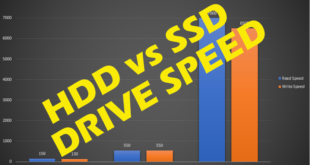Digital storage of data requires storage devices that can store a large amount of data or files on a smaller physical space. The advancement in technology is providing us with faster and better storage solutions. This is also necessary because digital formats like HDR and 4K are becoming new standards that require faster and large capacity storage drives. The Digital Data storages devices have infinite uses from using it in our computer for disk space to hosting server and more.
Some of the most popular storage drives are HDD, SSD, NVMe and more secured storage solution called RAID. HDD is a more traditional form of data storage with relatively slower speed and less capacity. On the other hand, SSD, NVMe and RAID are faster and better storage mediums with high read-write speed and better reliability. Let’s learn about these in detail to find out which one best fits your data storage needs.
HDD
HDD or Hard Disk Drive is a traditional form of data storage drives. Most of the computers and laptops are running on HDD because they cost a lot less when compared to SSD or other advanced storage drives. HDD is actually an electromechanical data storage drive. HDD has moving mechanical parts inside. Inside an HDD, you will find a number of rotating disks which is coated with magnetic material. This moving mechanical part of HDD makes it less reliable as they are more prone to wear and tear. The high speed rotating disk loses its storage capacity due to constant wear and tear as the disk rotates every time you read or write data on the drive. There is more possibility of data loss when it comes to HDD.
HDDs are there for more than 50 years. Earlier, they used to be really bulky and low capacity. However, their storage capacity is now greatly increased and the physical size has also decreased. The only problem with HDD is its slow speed because of moving mechanical parts. However, they are now available in huge storage capacities making it perfect for bulk data storage without spending a lot of money on expensive SSD or NVMe. All this makes it an economical storage solution with less cost per bit.
SSD
SSD stands for Solid State Drive. This is a new form of storage drive which doesn’t have any moving mechanical parts. This is why it is called Solid State drives. SSD is really fast with high read-write speed. They are also much compact in size, making it perfect for any task. However, for better speed and smaller size, the cost has also gone high. In comparison to HDD, SSD is around 1.5 times costlier.
But for the increased cost, you also get better reliability and less power consumption. SSD retains the data in flash memory and it doesn’t use a magnetic-based system like an HDD. There are no spinning drives in SSD and all the data is stored to a cluster of semiconductors.
You can also say that an SSD is nothing but a bigger version of flash drives which isn’t portable but is mounted to the computers.
NVMe
NVMe or Non-Volatile Memory Express is nothing but an interface protocol. This is built especially for Solid State Drives to make data storage even faster and better. VME was officially designed for enterprise needs. They are a scalable host controller interface for the rapid transfer of data. It is built as an entirely new and advanced way to access Non-Volatile Flash-based storage devices like SSDs.
Previously HDDs were accessed through an older SATA or SAS interface, which is really slow when compared to NVMe. But still, a number of computers are using SSDs with older SATA interface which was designed for slower HDDs. SSDs that are based on NVMe use PCle for reduced latency over SSDs.
Overall, NVMe based SSD is smaller, and advanced data storage drives with great speed and reliability.
RAID
With an increase in demand for larger drives, RAID technology is becoming increasingly popular. RAID or Redundant Array of Independent Disk allows us to store a large amount of data while providing better speed and reliability. Data stored using RAID technology is safe and secure.
In RAID we basically bundle a number of hard drives as one single drive. Multiple disks in a RAID are combined with different goals. Hence these variations are represented by a number after RAID. For example Raid 0. RAID technology is mostly used in file server because the controllers are expensive. But today any computer or servers are using RAID where the controller can either be hardware or software. RAID is the best storage solution nowadays with high speed, large storage capacity, and better reliability.
These are the most popular form of storage devices used in computers, laptops, and servers today. Each of these storage devices has its own benefit. The HDD is more economical, and you get a large capacity, SSDs can be faster but expensive and so on.
 Cheapest Linux VPS Home for Cheap Virtual Private Server
Cheapest Linux VPS Home for Cheap Virtual Private Server 




